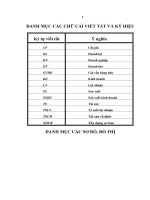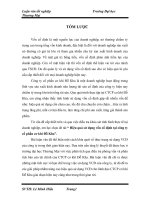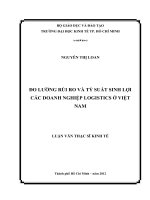Bài giảng tài chính doanh nghiệp chương 1 rủi ro và tỷ suất lợi nhuận
Bạn đang xem bản rút gọn của tài liệu. Xem và tải ngay bản đầy đủ của tài liệu tại đây (207.11 KB, 55 trang )
Chương 1
Rủi ro và tỷ suất lợi nhuận
Lợi
nhuận
:
các
khái
niệm
cơ
bản
1-1
1.
Lợi
nhuận
:
các
khái
niệm
cơ
bản
2. Rủi ro: các khái niệm cơ bản
3. Rủi ro riêng lẻ
4. Rủi ro thị trường (rủi ro danh mục)
5. Rủi ro và lợi nhuận: CAPM/SML
Investment returns
The rate of return on an investment can be
calculated as follows:
(Amount received – Amount invested)
Return =
________________________
1-2
Return =
________________________
Amount invested
For example, if $1,000 is invested and $1,100 is
returned after one year, the rate of return for this
investment is:
($1,100 - $1,000) / $1,000 = 10%.
What is investment risk?
Two types of investment risk
Stand-alone risk
Portfolio risk
1-3
Investment risk is related to the probability
of earning a low or negative actual return.
The greater the chance of lower than
expected or negative returns, the riskier the
investment.
Probability distributions
A listing of all possible outcomes, and the
probability of each occurrence.
Can be shown graphically.
1-4
Expected Rate of Return
Rate of
Return (%)
100150-70
Firm X
Firm Y
Selected Realized Returns,
1926 – 2004
Average Standard
Return Deviation
Small-company stocks 17.5% 33.1%
Large
-
company stocks
12.4
20.3
1-5
Large
-
company stocks
12.4
20.3
L-T corporate bonds 6.2 8.6
L-T government bonds 5.8 9.3
U.S. Treasury bills 3.8 3.1
Source: Based on
Stocks, Bonds, Bills, and Inflation: (Valuation
Edition) 2005 Yearbook
(Chicago: Ibbotson Associates, 2005), p28.
Investment alternatives
Economy Prob. T-Bill HT Coll USR MP
Recession
0.1 5.5% -27.0% 27.0% 6.0% -17.0%
1-6
Below avg
0.2 5.5% -7.0% 13.0% -14.0% -3.0%
Average
0.4 5.5% 15.0% 0.0% 3.0% 10.0%
Above avg
0.2 5.5% 30.0% -11.0% 41.0% 25.0%
Boom
0.1 5.5% 45.0% -21.0% 26.0% 38.0%
Why is the T-bill return independent
of the economy? Do T-bills promise a
completely risk-free return?
T-bills will return the promised 5.5%, regardless
of the economy.
No, T-bills do not provide a completely risk-free
return, as they are still exposed to inflation.
1-7
return, as they are still exposed to inflation.
Although, very little unexpected inflation is likely
to occur over such a short period of time.
T-bills are also risky in terms of reinvestment rate
risk.
T-bills are risk-free in the default sense of the
word.
How do the returns of HT and Coll.
behave in relation to the market?
HT – Moves with the economy, and has
a positive correlation. This is typical.
Coll.
–
Is countercyclical with the
1-8
Coll.
–
Is countercyclical with the
economy, and has a negative
correlation. This is unusual.
Calculating the expected return
P
r
r
return of rate expected r
N
^
^
=
=
∑
1-9
12.4% (0.1) (45%)
(0.2) (30%) (0.4) (15%)
(0.2) (-7%) (0.1) (-27%) r
P
r
r
HT
^
1i
ii
^
=+
++
+=
=
∑
=
Summary of expected returns
Expected return
HT 12.4%
Market 10.5%
USR
9.8%
1-10
USR
9.8%
T-bill 5.5%
Coll. 1.0%
HT has the highest expected return, and appears
to be the best investment alternative, but is it
really? Have we failed to account for risk?
Calculating standard deviation
deviation
Standard
=
σ
2
Variance
σ
=
=
σ
1-11
2
Variance
σ
=
=
σ
i
2
N
1i
i
P)r(rσ
∑
=
−=
ˆ
Standard deviation for each investment
(0.2)
5.5)
-
(5.5
(0.1)
5.5)
-
(5.5
P )r (r
22
N
1i
i
2
^
i
+
−=
=
∑
σ
2
1
1-12
15.2%
18.8% 20.0%
13.2% 0.0%
(0.1)5.5) - (5.5
(0.2)5.5) - (5.5 (0.4)5.5) - (5.5
(0.2)
5.5)
-
(5.5
(0.1)
5.5)
-
(5.5
M
USR
HT
CollbillsT
2
22
billsT
=
==
==
+
++
+
=
−
−
σ
σσ
σσ
σ
Comparing standard deviations
Prob.
T - bill
1-13
USR
HT
0 5.5 9.8 12.4 Rate of Return (%)
Comments on standard
deviation as a measure of risk
Standard deviation (σ
i
) measures
total, or stand-alone, risk.
The larger
σ
i
is, the lower the
1-14
The larger
σ
i
is, the lower the
probability that actual returns will be
closer to expected returns.
Larger σ
i
is associated with a wider
probability distribution of returns.
Comparing risk and return
Security Expected
return, r
Risk, σ
T
-
bills
5.5%
0.0%
^
1-15
T
-
bills
5.5%
0.0%
HT 12.4% 20.0%
Coll* 1.0% 13.2%
USR* 9.8% 18.8%
Market 10.5% 15.2%
* Seem out of place.
Coefficient of Variation (CV)
A standardized measure of dispersion about
the expected value, that shows the risk per
unit of return.
1-16
r
return Expected
deviation
Standard
CV
ˆ
σ
==
Risk rankings,
by coefficient of variation
CV
T-bill 0.0
HT 1.6
Coll. 13.2
USR
1.9
1-17
USR
1.9
Market 1.4
Collections has the highest degree of risk per unit
of return.
HT, despite having the highest standard deviation
of returns, has a relatively average CV.
Illustrating the CV as a
measure of relative risk
A B
Prob.
1-18
σ
A
= σ
B
, but A is riskier because of a larger probability of
losses. In other words, the same amount of risk (as
measured by σ) for smaller returns.
0
Rate of Return (%)
Investor attitude towards risk
Risk aversion – assumes investors dislike
risk and require higher rates of return to
encourage them to hold riskier securities.
1-19
Risk premium – the difference between
the return on a risky asset and a riskless
asset, which serves as compensation for
investors to hold riskier securities.
Portfolio construction:
Risk and return
Assume a two-stock portfolio is created with
$50,000 invested in both HT and Collections.
A portfolio’s expected return is a weighted
average of the returns of the portfolio’s
1-20
average of the returns of the portfolio’s
component assets.
Standard deviation is a little more tricky and
requires that a new probability distribution for
the portfolio returns be devised.
Calculating portfolio expected return
:average weighted a is r
N
^
^
p
^
1-21
6.7% (1.0%) 0.5 (12.4%) 0.5 r
rw r
p
^
N
1i
i
^
i
p
^
=+=
=
∑
=
An alternative method for determining
portfolio expected return
Economy Prob. HT Coll Port.Port.
Recession 0.1 -27.0% 27.0% 0.0%0.0%
Below avg
0.2
-
7.0%
13.0%
3.0%3.0%
1-22
Below avg
0.2
-
7.0%
13.0%
3.0%3.0%
Average 0.4 15.0% 0.0% 7.5%7.5%
Above avg 0.2 30.0% -11.0% 9.5%9.5%
Boom 0.1 45.0% -21.0% 12.0%12.0%
6.7% (12.0%) 0.10 (9.5%) 0.20
(7.5%) 0.40 (3.0%) 0.20 (0.0%) 0.10 r
p
^
=++
++=
Calculating portfolio standard
deviation and CV
3.4%
6.7)
-
(7.5
0.40
6.7) - (3.0 0.20
6.7) - (0.0 0.10
2
1
2
2
2
p
=
+
+
=
σ
1-23
0.51
6.7%
3.4%
CV
3.4%
6.7) - (12.0 0.10
6.7) - (9.5 0.20
6.7)
-
(7.5
0.40
p
2
2
p
==
=
+
+
+
=
σ
Comments on portfolio risk
measures
σ
p
= 3.4% is much lower than the σ
i
of
either stock (σ
HT
= 20.0%; σ
Coll.
= 13.2%).
σ
p
= 3.4% is lower than the weighted
average of HT and Coll.’s
σ
(16.6%).
1-24
p
average of HT and Coll.’s
σ
(16.6%).
Therefore, the portfolio provides the
average return of component stocks, but
lower than the average risk.
Why? Negative correlation between stocks.
General comments about risk
σ ≈ 35% for an average stock.
Most stocks are positively (though
not perfectly) correlated with the
1-25
not perfectly) correlated with the
market (i.e., ρ between 0 and 1).
Combining stocks in a portfolio
generally lowers risk.









